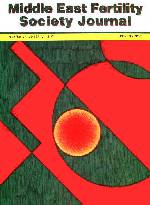
|
Middle East Fertility Society Journal
Middle East Fertility Society
ISSN: 1110-5690
Vol. 12, Num. 2, 2007, pp. 144-144
|
Middle East Fertility Society Journal, Vol. 12, No. 2, 2007, pp. 144-144
BOOK
REVIEW
Mohamed Aboulghar, M.D.
Professor in Obstetrics and Gynecology, Faculty of Medicine, Cairo University
Code Number: mf07026
Issues
in women’s health: International and Egyptian Perspective. Mahmoud F. Fathalla. Assiut University Press, Egypt 2007. 273 pages.
The book covers a wide area in the field of women’s
health. The first chapter is an introduction which covers health development
and the human rights issue specifically concentrating on women’s health and the
issues of international concern on women’s health.
Then the author on the next chapter proceeds to
discuss the difference between man and women from the health perspective and
what is missing in the health of the female. He then discusses the dangers of
female circumcision (female genital mutilation) and its trauma and harmful
effect on the health the girl. The discussion also covers the choice of fertility,
the right of the women to have a baby and the right for safe motherhood. He
lightly touches on the abortion dilemma particularly in areas where there are
restrictions in induction of abortion and also touches on the menopause issue.
He devoted a whole chapter to health and being a
woman, and the sensitive issue that the woman is not a womb and the different
factors which determine the women’s health including the unfair burden which
women bear.
He elaborates on the sexual and reproductive rights as
parts of human rights, and he refers to the declaration and platform of action
adopted by 187 UN member states in 1995 international conference on women. This
makes explicit that the human rights of women include the rights of all women
to have control over and decide freely and responsibly on matters related to
sexuality including sexual and reproductive health free of coercion,
discrimination and violence.
One chapter entitled “The missing
females” discusses an international perspective on prenatal sex selection and
discrimination against the girl as child and compares this with international
data. He discusses in details why boys are preferred to the parents as children
and possible changes of this attitude during recent years.
A whole chapter on the health of the adolescent girl
including the demographic youth bulge and how can we cope with the population
momentum and the subject of gender differential and the difficult choices of
the girl and the problem of very young mothers and their ignorance, which makes
a problem to find a solution.
According to EDHS 2005
data the most commonly ever used medical method of contraception is the IUD
(61%). The median age at first at first marriage is 20.4 years. There have been
substantial increase over time in the median age at marriage within all areas
of Egypt, although the changes in rural upper Egypt being generally marked.
Consanguinity
is very common in Egypt around one third of women marry a relative and over
half of them marry a first cousin.
There is a whole chapter devoted
to the sex matters in women health and the sexually transmitted diseases, with
very important and informative data.
Infertility takes a very
important part of the book as well as family planning. Both are thoroughly
discussed in the books in great details
Safe motherhood is also discussed
in details with a touch on maternal mortality.
The author also discusses
victimization as a part of being females. He included the health consequences
of violence against women with different types and definitions of violence. And
also domestic violence in Egypt, the problem of rape and what is called honor
crimes in Egypt.
This book is a very interesting
book with lots of very important data which are all up to date. It touches on
very important points and it deserves reading.
Copyright © Middle East Fertility Society
| 